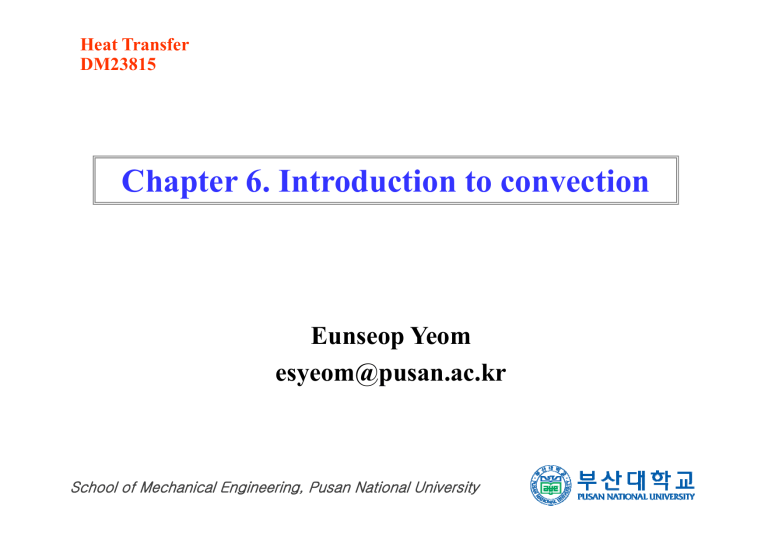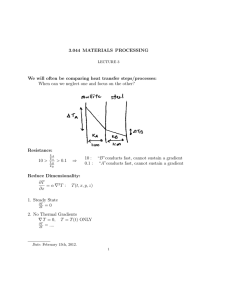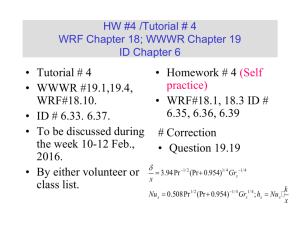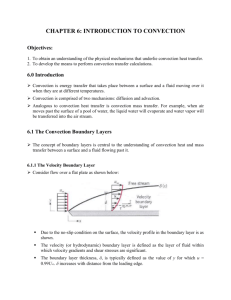
Heat Transfer DM23815 Chapter 6. Introduction to convection Eunseop Yeom esyeom@pusan.ac.kr School of Mechanical Engineering, Pusan National University 6. Convection Heat transfer due to a superposition of energy transport by the random motion of the molecules (diffusion), and by the bulk motion of the fluid (advection). (The term convection refers to heat transfer that will occur between a solid surface and the adjacent fluid when they are at different temperatures.) Newton's law of cooling Convective heat flux hTs T qconv Ts and T∞ : Temperatures at surface and fluid [K]. h : Convection heat transfer coefficient [W/m2·K]. Example of convection Cooling of boiled-egg Fluid motion forced by fan or buoyancy forces cool boiled-egg down. 2 6. Convection Cooling fan Forced convection Fluid motion is forced by external means, such as a fan, a pump, or the wind. Hot air balloon Natural (or free) convection Fluid motion is set up by buoyancy effects resulting from density difference caused by temperature difference in the field. Convection with phase change A latent heat exchange is associated with phase change between liquid and vapor states of the liquid. Two special cases are boiling and condensation. Convection heat transfer coefficient Process h depends on conditions in the boundary layer, which are influenced by ① Surface geometry ② The nature of the fluid motion ③ An assortment of fluid thermodynamic properties h (W/m2·K) Free convection Gases 2 - 25 Liquids 50 - 1,000 Forced convection Gases 25 - 250 Liquids 100 - 20,000 Convection with phase change 3 Boiling and condensation 2,500 - 100,000 6. Convection Dimensionless Parameters Reynolds number Re inertia force viscous force A criterion to determine the change from laminar to turbulent flow. Prandtl number Pr molecular diffusivity of momentum molecular diffusivity of heat A measure of relative effectiveness of momentum and energy transport by diffusion in the velocity and thermal boundary layers. Nusselt number Nu 4 heat transfer by convection heat transfer by conduction When convection and conduction have similar magnitude, Nusselt number closes to one. Continue 6. Convection Stanton number St heat flux to the fluid h ρC p u thermal capacity of fluid flow Stanton number arises in the consideration of the geometric similarity of the momentum boundary layer and the thermal boundary layer. Eckert number Ec kinetic energy of flow boundary layer enthalpy difference The magnitude of the Eckert number becomes the criterion in deciding whether the viscous-energy-dissipation effects should be considered in the heat transfer analysis. Grashof number Gr L 5 buoyancy force viscous force g T x - T L c 2 3 β: the coefficient of thermal expansion It is important parameter in the study of natural convection. 6.1.1 Velocity Boundary Layer Velocity boundary layer δ (x) - A consequence of viscous effects associated with relative motion between a fluid and a surface. - For external flow, the distance from the surface of the plate where the velocity becomes 99% of the free-stream value. On the flat plate In a circular tube Critical Re Hydrodynamic entry length 6 6.1.1 Velocity Boundary Layer Surface Shear Stress When a viscous fluid is stirred, the force resisting the relative motion of solid surfaces occurs. Friction force per unit area, τ τs μ u y y 0 [N/m2] μ : viscosity A measure of resistance to flow, and a strong function of temperature A more practical approach in external flows relate τs to the upstream velocity u∞ as Cf τs u 2 /2 where Cf is the dimensionless friction coefficient(마찰계수), whose value in most cases is determined experimentally. Thus, the friction force (Ff) over the entire surface (As) is determined from u 2 F f C f As 2 7 6.1.1 Thermal boundary layer Thermal boundary layer δt(x) - As velocity boundary layer develops, a thermal boundary layer also develops. When there is temperature difference between the fluid and surface. - A consequence of heat transfer between the surface and fluid. - The distance from the surface at which the temperature difference equals 99% of temperature difference between fluid and surface. δt 8 Ts T y 0.99 T s T As thermal boundary layer develops along streamwise direction, thermal gradient at surface is varied. 6.2 Local and Average Convection Coefficients Considering condition that fluid flows over a surface of arbitrary shape and area, surface heat flux and convection heat transfer coefficients vary along surface. Total heat flux based on local heat flux q qdAs Ts T hdAs As As Total heat flux based on Average convection coefficient h h 9 1 As hdA s As w 6.3 Laminar and Turbulent Flow Velocity boundary layer development on a flat plate - Velocity distribution determines advection component of thermal energy transfer. - Similar to velocity boundary layer, thermal boundary layer grows along streamwise direction. - Turbulent mixing promotes increase in heat transfer. - Difference in velocity and thermal boundary layers is much smaller in turbulent flow than in laminar flow. 10 Variation of boundary layer(δ) and heat transfer coefficient(h) for isothermal flat plate 6.4 boundary Layer Equations Continuity equation (연속 방정식) This is essentially the equation for the conservation of mass. Differential control volume ρv ρv dy y dy ρu ρu ρu dx x Net rate at which Rate of increase of mass enters the = mass stored within control vol. the control vol. y x x, y dx ρv dz 1 ρu dy ρu 11 ρu dx dy ρv dx ρv ρv dy dx 0 x y





